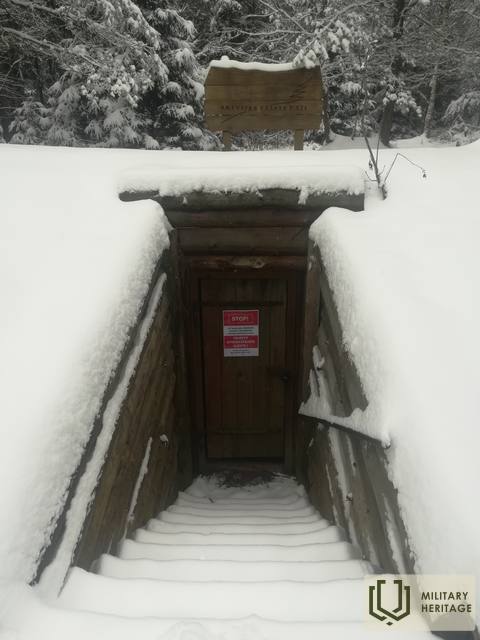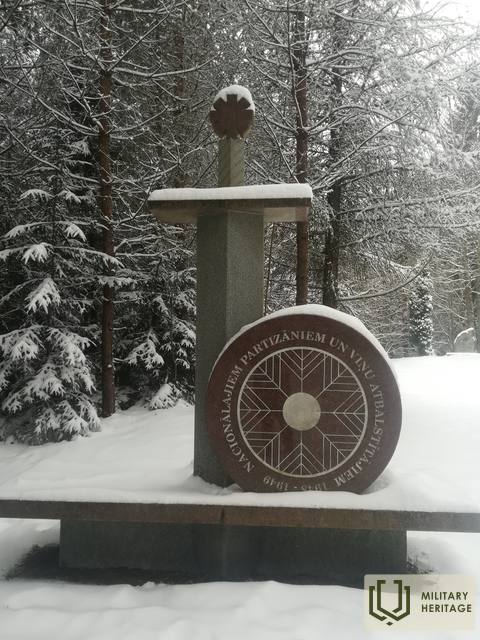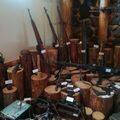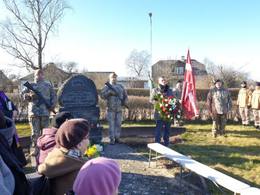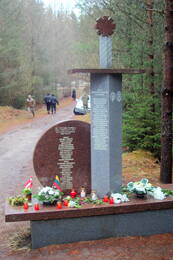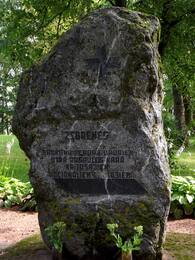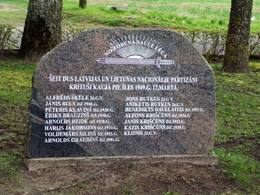Ile partizanų grupė III Nacionaliniai partizanai
1946 m. susikūrusiai Kabilės partizanų grupei, Ilės partizanų grupei vadovavo vadas Visvaldis Brizga, pravarde Kārlis Krauja.
Iš pradžių grupė veikė Lietuvoje, bet 1947 m. grįžo į Latvijos Žiemgalos regioną. 1948 m. grupėje buvo 27 nariai. 1948/1949 m. žiemą jie pasistatė bunkerį netoli Ylės miškų ūkyje, 300 metrų į šiaurę nuo Priedīšių dvaro.
Pagal savo dydį tai didžiausias žinomas uždaras nacionalinių partizanų bunkeris Latvijoje. 1949 m. kovo 17 d. 24 vyrai, tarp jų 15 latvių ir 9 lietuviai, kovėsi mūšyje su SSRS Vidaus reikalų liaudies komisariato (NKVD) kariuomene.
Grupės vadas mūšyje nedalyvavo. Jis žuvo 1950 m. vasario 24 d. per mūšį Salduse, Strikių gatvėje 33/35.
Daugiau informacijos šaltinių
„TE“: Īlės partizanų bunkeris – „YouTube“ > https://www.youtube.com/watch?v=kuKkLYD3bhY
Istorija iš Ylės nacionalinių partizanų bunkerio - „YouTube“ > https://www.youtube.com/watch?v=_ACJcoyCJyM
Mūšio rekonstrukcija, kurioje užfiksuotas prieš 62 metus įvykdytas išpuolis prieš Ylės nacionalinių partizanų bunkerį – „YouTube“
Susijusios vietos
Rendos nacionalinio pasipriešinimo judėjimo muziejus
Muziejus yra įsikūręs už kelių kilometrų nuo Rendos parapijos centro. Parodoje pasakojama apie 50 metų trukusį pasipriešinimo judėjimą Latvijoje: pasipriešinimą pirmajai sovietų okupacijai, pasipriešinimą nacistinės Vokietijos okupacijai ir ginkluotą bei nesmurtinį pasipriešinimą sovietų okupacijai. Paroda įsikūrusi dviejuose pastatuose. Pirmajame pastate saugomi pirmosios sovietų ir vokiečių okupacijos įrodymai. Parodoje eksponuojamas restauruotas tvarto pastatas, kuriame dėmesys sutelktas į Nacionalinį partizaninį karą. Tarp dviejų pastatų yra autentiško išplanavimo bunkeris ir kareivių naudoti apkasai. Netoli muziejaus Rendoje esantys kasinėjimai, blindažo aikštelė ir kliūčių ruožas tarnauja kaip jaunimo sargybinių ir visų susidomėjusiųjų treniruočių aikštelė. Apsilankymus būtina užsisakyti iš anksto.
Vienas didžiausių nacionalinių partizanų mūšių, vadinamas Āpūzniekų mūšiu, įvyko 1946 m. sausį netoli čia. Mūšyje Kabilės nacionalinis partizanų būrys nugalėjo daug didesnes okupacinės valdžios pajėgas. Mūšio vietoje, kurioje yra informaciniai stendai, dabar įrengta poilsio aikštelė.
Nacionalinių partizanų memorialinė vieta Striķu gatvėje, Saldus
Memorialas yra Striķu ir Lauku gatvių sankryžoje.
Tragiškai kruvinas įvykis šioje vietoje įvyko taikos metu 1950 m. vasario 24 d. Salduse, Strikių (tuometinės 5. augusto) gatvėje, netoli 33-iojo ir 35-ojo namų. Šios gatvės 33-iajame name, po Žiemgalos miško brigadų grupės su jos štabo bunkeriu Ylės miškuose sunaikinimo 1949 m. kovo mėn., gyvi ir nesugauti trys miško brigados, tarp jų pats grupės vadas Kārlis Krauja (tikrasis vardas Visvaldis Brizga) ir jo bendrininkas Vilis Krusts. Jie tikėjosi praleisti 1950 m. žiemą Bergmanių namuose Salduse, tačiau buvo suimti ir susekė. Abu namus apgulė apie 30 čekistų, o anksti ryte įvyko įnirtingos kovos. Čekistai buvo apšaudyti iš abiejų namų, tačiau pralaimėję triuškinančiai persvarai, abu partizanai bandė pabėgti į netoliese esantį Veidės mišką. Tačiau čekistai partizaną Krustą nušovė jau ant namo laiptų, o Kraują – apie 80 metrų toliau miško link.
Abu namai buvo padegti, gyventojų iš anksto paprašius išeiti ir pažadėjus, kad jų gyvybės bus išsaugotos. Yra pranešimų, kad žmonės išėjo, bet vis tiek buvo sušaudyti vietoje. Tarp sušaudytųjų arba dūmuose uždususių žmonių buvo tėvas ir sūnus Kursinskiai iš 35-ojo namo, kurie rėmė partizanus, bet taip pat buvo sušaudyta Kursinskių namo gyventoja Leontine Ezerkalni, kuri nežinojo apie savo šeimininko ryšius su miško brigadomis.
Ylės nacionalinių partizanų bunkeris
Bunkeris yra Zebrenės seniūnijoje, Ylės girininkijoje, išsukus iš kelio P104 Bikstai–Aucė.
Ylės nacionalinių partizanų grupė, kuriai vadovavo Karlis Krauja, susikūrė 1947 m. Grupės vadu buvo išrinktas V. Ž. Brizga (slapyvardis K. Krauja). 1948 m. spalį ši grupė susijungė su lietuvių nacionalinių partizanų grupe. Kraujos grupė veikė Jelgavos apskrityje, joje buvo 27 nacionaliniai partizanai. 1948 m. spalį Jelgavos apskrities Lielaucės valsčiuje, netoli Ylės girininkijos, 300 m į šiaurę nuo sodybos „Priedaiši“, Kraujos grupė įsirengė požeminį bunkerį. Jo bendras ilgis, įskaitant slaptus priėjimus, buvo 45 metrai. Aplink bunkerį buvo išdėliota 70 nuotoliniu būdu valdomų minų. Bunkeryje buvo įrengta krosnis, šulinys, tualetas ir sandėlis.
1949 m. kovo 17 d. bunkeryje buvę 24 partizanai stojo į savo paskutinį mūšį su 760 Valstybės saugumo ministerijos (čekistų) karių. Po mūšio 9 partizanai buvo suimti, o 15 žuvo, iš jų – 8 latviai ir 7 lietuviai.
1992 m. krašto apsaugos kariai kartu su Dauguvos vanagais atkūrė susprogdintą bunkerį. Toje vietoje pastatytas Baltasis kryžius, paminklinis akmuo ir granito stela.
Bunkerio viduje yra krosnelė, stalas ir siauri gultai, ant kurių miegojo partizanai. Prie bunkerio yra informacijos stendai, paminkliniai akmenys su partizanų vardais ir pavardėmis.
Memorialas kovos su sovietine okupacija ir komunistinėmis represijomis aukoms Zebrenės parapijoje
Memorialas kovojusiems su sovietų okupaciniu režimu ir komunistinių represijų aukoms Zebrenės parke, Rengės dvaro parke, buvo atidengtas 1995 m. rugsėjo 1 d. Ant grublėto riedulio pavaizduotas kryžius ir iškalti žodžiai: „Zebrenės raudonojo teroro aukoms, Antrajame pasauliniame kare žuvusiems tautos kovotojams“. Memorialo sukūrimą finansiškai parėmė organizacija „Daugavos Vanagi“.
Ylės nacionalinių partizanų brolių kapinės Virkaus kapinėse, Bērzės parapijoje
Ylės nacionalinių partizanų brolių kapinės Bērzės parapijos Virkaus kapinėse buvo įkurtos 1992 m. lapkričio 14 d., kai čia buvo palaidoti 15 partizanų, žuvusių 1949 m. kovo 17 d. Ylės mūšyje. Tai tapo įmanoma po to, kai 1992 m. liepos 18 d. Nacionalinė gvardija kartu su organizacija „Daugavas Vanagi“ ir Latvijos istorijos tyrimų darbo grupe „Ziemeļblāzma“, dalyvaujant kitų tautiškai nusiteikusių organizacijų atstovams, atkasė 15 latvių ir lietuvių miško brolių, palaidotų susprogdintame partizanų bunkeryje Zebrenės parapijos Ylės girininkijoje, palaikus.
Atminimo akmuo Ylės mūšyje žuvusiems nacionaliniams partizanams buvo atidengtas 1993 m. gegužės 29 d. Jį sukūrė Alfonsas Kalniņšas („Edgarsas“), vienas iš išlikusių gyvų 1949 m. kovo 17 d. mūšio dalyvių. Taisyklingos formos granito plokštėje pavaizduotas kardas ir kylanti saulė, joje išgraviruoti 15 žuvusių nacionalinių partizanų vardai ir užrašas:
„Saulė patekėjo nuo kalavijo. Čia ilsisi Latvijos ir Lietuvos nacionaliniai partizanai, žuvę 1949 m. kovo 17 d. Ylės mūšyje.“
Susijusi istorija
Visvalžo Brizgos (Kārļa kraujos) tautinių partizanų grupė
Jungtinė Latvijos ir Lietuvos nacionalinių partizanų grupė „Kārļa Krauja“ buvo viena didžiausių pasipriešinimo grupių Latvijos teritorijoje 1947–1949 m.




